First off, you've got the flight, which unless you're hopping over from some other stint in Asia, is always a tremendous bitch. Then there's the question of, where do you go? I know many people who are intimidated by the language barrier who decide that the only place they feel comfortable in Japan is Tokyo, end up spending a few nights there, visit a Ueno Park, and sum up Japan in a couple cheap sentences. Please, if you're going to Japan, don't let your only experience be Tokyo. It's like going to the States and basically only experiencing the hectic pace of life in New York.
 |
| Kiyomizu Dera in Kyoto - great city for experiencing Japan |
LOCATION: If you do feel too intimidated to venture outside the cities, I highly recommend spending a week or more with Kyoto as your base city. Many flights are available to Kansai International Airport, where you can hop a train over to Kyoto Station, and then grab a taxi wherever you're staying. The Kyoto buses are easy to use, the subway is completely manageable, there are umpteen temples and markets to visit, and you'll be able to get a much better experience of a culturally rich Japanese city than if just visiting Tokyo. The pace of life is slightly slower, and I find the people a little more patient and polite. Furthermore, if sick of Kyoto, you can venture out on a short stint via the train lines over to Nara to see the Daibutsu (Great Buddha) and all those lovely deer, or if craving a bit of fast-paced city life, you've only got about a half hour or so before you're in Osaka, stuffing yourself with screaming hot takoyaki (octopus pancake balls) and snapping photos of the neon lights and huge statue signs on Dotoburi.
 |
| Look for the midori no madoguchi |
TRAVEL: If you plan on skipping around the country, I can't emphasize enough how wonderful the Japan Rail Pass is. It's a good deal when going on the shinkansen and using a number of the local trains. There are a number of agencies where you can pick up a voucher in your home country listed on the site: http://www.japanrailpass.net/eng/en001.html. When you arrive in Japan, just look for a midori no madoguchi sign in the airport or a big station and let the agent that takes care of you know which day you would like the pass to begin. You can also reserve seats on the shinkansens you would like to travel on at this time. Since you're probably going to be jet lagged and perhaps a bit of excited mixed with a good dose of cranky when you arrive, it's a great idea to print out all the dates and times of the trains that you would like to reserve to hand to the agent, since your agent may not speak English or may be particularly shy. I find this site very helpful when looking up times: http://www.hyperdia.com/. When writing down your times, write the date using the kanji 日 for day and 月 for month. For the times, use the military time method (ex. 13:30 for 1:30 pm). Grab your departure and arrival station locations in kanji (wikipedia is a good source to copy those place names). Handing over a sheet of times/dates for your requested reservations will produce a smoother experience, and a look of gratitude and confirmed understanding from your agent. Works like a charm.
 |
| Awesome book to help with your food needs! |
FOOD: You could just standby and pick out restaurants with English menus or that only have the plastic food displayed at the front window. And while I've yet to have a bad experience with the food at these restaurants, there are more interesting food stuffs to be had. The more you seem to have done your research and show that you like food, the better recommendations you'll receive from staff at local favorites and fantastically special little Japanese restaurants. Personally, I recommend three pretty easy things: First, learn your numbers in kanji so that you know what your wallet is going to be in for. Second, buy this book: What's What in Japanese Restaurants. The little guide includes restaurant menu items divided by food category. If you're unsure how to say something in Japanese, you can point to the item's page in the book, and likewise also try to decipher the menu you are looking at. Seriously, it's an excellent tool when exploring all sorts of cuisine. Third, be friendly! Smile! If something looks good that someone else has ordered, ask the proprietor "Core-wa nan deska?" and point to what they are eating. Sometimes this is the best way to find out what the restaurant specializes in, particularly if everyone is chowing down on a similar looking dish.
So that's my little guide. I hope that you'll all venture out and experience Japan on your own. Of course, you can always book a tour, which would be the easiest thing to do, though you'll be restricted in what you can explore, and I find sometimes that traveling around in a herd of who knows how many can be hit or miss since you can't pick your own travel companions.

No comments:
Post a Comment